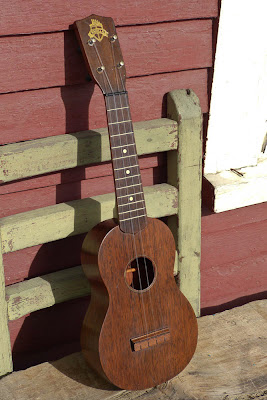c.1930 Favilla Mahogany Soprano Ukulele
I spotted this cute old plain-Jane Favilla and immediately scooped it up. It's in rather good condition but does show the usual "lifetime wear" of nicks and scratches and finish checking on the body. It's remarkably crack free with only 3 tiny little with-grain hairline cracks on the center of the back (which didn't go through the wood and have been drop-filled with glue & wood dust for stability).
Other work included a fret level/dress, cleaning, and setup. It plays great with just a hair over 1/16" at the 12th fret action -- otherwise known as "spot on."
If you haven't had the joy of owning or playing a nice old Favilla in the "Martin fashion" and shape, they've certainly got their own thing going. I think of them as a step up from a similar-style Gretsch towards a Martin, but they tend to have a simpler, less-sustained or overtoney sound than a style 0 Martin. This can be a benefit to many players, though!
...and that's what you get with this guy: a neck that feels remarkably Martin-ish (plenty of room and very comfortable with a mild D shape) and a sweet, warm, and bell-like front to the tone. This makes it a great plucky strummer in prime 20s/30s fashion and an even better fingerpicker.
Ebony nut and stamped-in gold Favilla label. I've added some extra washers to the original bakelite tuner pegs so that they turn more smoothly. They work just dandy, now.
Rosewood board with low, flatter-profile brass frets. The dots appear to be cream celluloid or clay.
Cute, simply rosette. The body wood on this is extra thin, just like Martins. That's why they sound so good! Nice bracing helps, though, too...
...and speaking of bracing, one of the back braces has a small chink and hairline split at its edge: nothing to worry about, it's stable. It must've just dried out a bit.
Mahogany bridge with a rosewood saddle -- still glued well after all these years, and a nice upgrade to just a one-type wood bridge.
The sides have some scuffs and scratches but are crack-free, too.
The finish used on these guys is similar to the satin Martin finishes: just simple and classy and smooth to the touch.
Here's that trio of roughly 1" not-through hairline cracks. I drop-filled them with glue and mahogany dust to keep them stable for the future and seal them up so they won't dry out too much more.















Comments